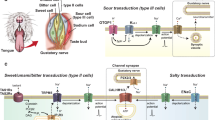Abstract
Superfusion of the isolated sympathetic ganglia of the frog with nicotinic agonists (suberyldicholine, tetramethylamonium, and dimethylphenylpiperazinium), as well as acetylcholine in the presence of atropine led to a brief depolarization of the neurons and blockade of synaptic transmission. The muscarinic agonists methylfurmethide (MFM) and methyldilvasen, cis−, L(+), as well as acetylcholine elicited a stable depolarization which is not accompanied by disturbance in transmission. Oxotremorine at a concentration of 1·10−5 M did not lead to the depolarization of the post-synaptic membrane, but at a concentration of 1·10−6 M decreased the quantal EPSP content twofold, which indicates that the presynaptic receptors belong to the M2 subtype. Inhibition of acetylcholinesterase significantly intensified the postsynaptic effect of MFM: a shift of the concentration-effect curve took place toward the side of lower MFM concentrations. It was shown that the post-synaptic muscarinic receptors of the ganglionic neurons possess varied sensitivity to the enantiomers of methyldilvasen and, consequently, are stereospecific. The identified functional properties of the cholinoreceptors of the ganglionic neurons explain the set of changes in synaptic transmission under conditions of the prolonged presence of a mediator in the synaptic cleft.
Similar content being viewed by others
Literature Cited
V. Yu. Bol'shakov, N. Ya. Lukomskaya, and L. G. Magazanik, “Post-synaptic effects of acetylcholinesterase agents in the sympathetic ganglion of the frog,” Dokl. Akad. Nauk SSSR,291, 5, 1260–1263 (1986).
V. Yu. Bol'shakov, M. V. Samoilova, N. Ya. Lukomskaya, and L. G. Magazanik, “Pre-synaptic effects of acetylcholinesterase agents in sympathetic ganglia,” Dokl. Akad. Nauk SSR,285, 3, 731–734 (1985).
N. Ya. Lukomskaya, “Change in cholinoreception in the superior cervical sympathetic ganglion of the cat after denervation,” Zh. Evol. Biokhim. Fiziol.,5, 1, 65–73 (1969).
M. Ya. Mikhel'son, O. I. Kolganova, N. Ya. Lukomskaya, et al., “Comparative study of the stereospecificity of the cholinoreceptors,” Zh. Evol. Biokhim. Fiziol.,15, 1, 42–47 (1979).
K. F. Trunus, “Electrophysiological study of the properties of the cholinoreceptors of the neurons of the frog sympathetic ganglia,” Neirofiziologiya,11, 5, 475–481 (1979).
D. A. Brown and A. Constanti, “Intracellular observations on the effects of muscarinic agonists on rat sympathetic neurones,” Br. J. Pharmacol.,70, 4, 593–608 (1980).
D. A. Brown, A. Forward, and S. Marsh, “Antagonist discrimination between ganglionic and ileal muscarinic receptors,” Br. J. Pharmacol.,70, 2, 362–364 (1980).
K. J. Chang and D. J. Triggle, “Stereoselectivity of cholinergic activity in series of 1,3-dioxalanes,” J. Med. Chem.,16, 6, 718–720 (1973).
B. L. Ginsborg and S. Guerreo, “On the action of depolarizing drugs on sympathetic ganglion cells of the frog,” J. Physiol.,172, 2, 189–206 (1964).
R. Hammer and A. Giachetti, “Muscarinic receptor subtypes: M1 and M2 biochemical and functional characterization,” Life Sci.,31, 26, 2991–2998 (1982).
K. Koketsu and M. Yamada, “Presynaptic muscarinic receptors inhibiting active ACh release in the bullforg sympathetic ganglion,” Br. J. Pharmacol.,77, 1, 75–82 (1982).
K. Kuba and K. Koketsu, “Synaptic events in sympathetic ganglia,” Prog. Neurobiol.,11, 2, 77–169 (1978).
N. Ya. Lukomskaya, A. Ya. Ivanov, and L. G. Magazanik, “Blockade and spontaneous recovery of ganglionic transmission after treatment by irreversible inhibitors of cholinesterase,” Gen. Pharmacol.,11, 1, 83–87 (1980).
K. Morita, R. A. North, and T. Tokimasa, “Muscarinic agonists inactivate potassium conductance of guinea-pig myenteric neurones,” J. Physiol.,333, Dec., 125–139 (1982).
R. A. North, B. E. Slack, and A. Surprenant, “Muscarinic M1 and M2 receptors mediate depolarization and presynaptic inhibition in guinea-pig enteric nervous system,” J. Physiol.,368, Nov., 435–452 (1985).
V. I. Skok, “Ganglionic transmission: morphology and physiology,” in: Pharmacology of Ganglionic Transmission, ed. by D. A. Kharkevich, Springer, Berlin (1980), pp. 9–39.
R. L. Volle, “Modification by drugs of synaptic mechanisms in autonomic ganglia,” Pharmacol. Rev.,18, 2, 839–869 (1966).
R. L. Volle, “Ganglionic actions of anticholinesterase agents, catecholamines, neuromuscular blocking agents, and local anaesthetics,” in: Pharmacology of Ganglionic Transmission, ed. by D. A. Kharkevich, Springer, Berlin (1980), pp. 385–410.
Additional information
I. M. Sechenov Institute of Evolutionary Physiology and Biochemistry, Academy of Sciences of the USSR, Leningrad. Translated from Neirofiziologiya, Vol. 20, No. 2, pp. 227–234, March–April, 1988.
Rights and permissions
About this article
Cite this article
Bol'shakov, V.Y., Lukomskaya, N.Y. Synaptic effects of nicotinic and muscarinic agonists in sympathetic ganglia of the frog. Neurophysiology 20, 172–177 (1988). https://doi.org/10.1007/BF02141334
Received:
Issue Date:
DOI: https://doi.org/10.1007/BF02141334




